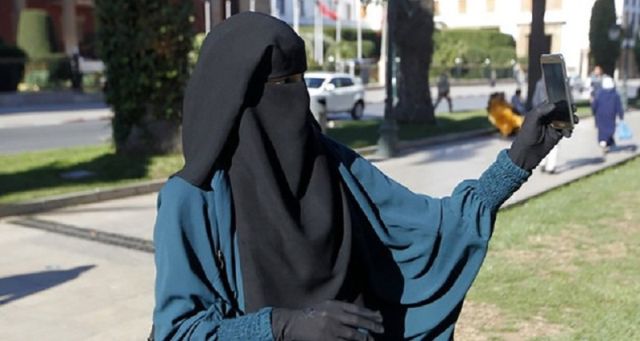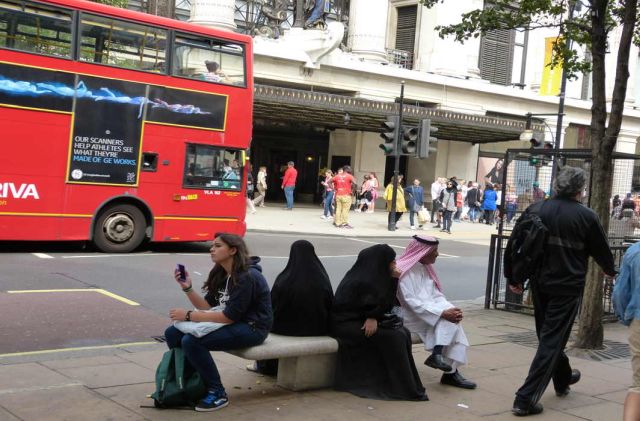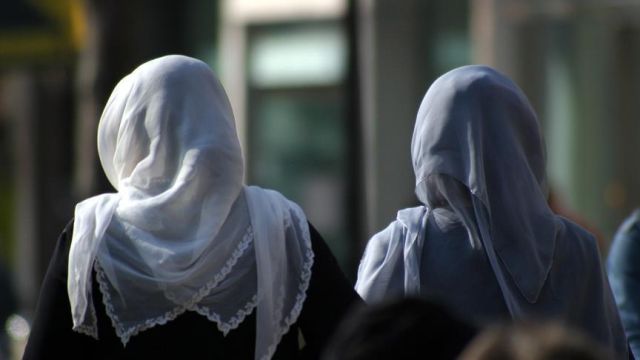
by admin | May 25, 2021 | Muslim World
 Copenhagen : A Turkish tourist in Denmark has been fined for breaching a controversial law that bans Islamic veils, including the niqab and burqa, in public places.
Copenhagen : A Turkish tourist in Denmark has been fined for breaching a controversial law that bans Islamic veils, including the niqab and burqa, in public places.
According to West Jutland police, a 48-year-old Turkish citizen was fined 1,000 kroner ($119) at the police station in Arhus where she was attempting to extend her tourist visa.
With the help of a translator, she said she was unaware that the new law had come into effect but would pay the fine. Due to her status in the country as a tourist, she was required to pay the full amount of the fine at the time of the citation.
Under the new legislation that came into effect on August 1, wearing a burqa, which covers the entire face, or wearing a niqab, which only shows the eyes, is a criminal offense. First-time offenders are required to pay 1,000 kroner, second-time offenders 2,000 kroner and third-time offenders 5,000 kroner. Repeat offenses could trigger fines of up to 10,000 kroner or a jail sentence of up to six months. A 28-year-old woman became the first person to be fined in Denmark after the law came into effect.
Since the implementation of the so-called “burqa ban,” nationwide protests have taken place decrying the attack on freedom of religion and expression.
The government says the law is not aimed at any religion and does not ban headscarves, turbans or the traditional Jewish skull cap.
The Danish law allows people to cover their face when there is a “recognizable purpose” like cold weather or complying with other legal requirements, such as using motorcycle helmets. Anyone forcing or threatening a person to wear garments covering the face can be fined or face up to two years in prison.
Austria, France, and Belgium have similar laws.
—SM/UNA-OIC

by admin | May 25, 2021 | Opinions
 By Saeed Naqvi,
By Saeed Naqvi,
In normal times Britain’s former Foreign Secretary Boris Johnson’s observation that burqa-clad women resemble walking “letter boxes” and “bank robbers” would evoke laughter. But these are not normal times.
Just when liberals were beginning to pelt stones at him, a startling turn to the debate was given by Taj Hargay, Imam of Oxford. “The burqa is a Wahabi fifth column… We will wake up in the Islamic Republic of Britain.”
Johnson’s observation is mischievous, and has a political purpose, the Imam’s an exaggeration. The observations are troubling for an Indian Muslim.
I would avoid being judgemental on a community which has been under immense pressure because of rampaging Islamophobia since the 1990s. And yet, I cannot help asking: Is the burqa a response to nasty Islamophobia or a means of aggravating it?
Aggravation of the problem is surely not our purpose. Then whose purpose is served by Muslim women floating around Oxford Circus in gear which distances them, in geometrical progression, from the host population? The clerics, eager to consolidate their congregations? Wouldn’t it be wonderful if these congregations had in their midst scholars, doctors, writers, scientists, entrepreneurs, rather than pliant women fitting Boris Johnson’s description.
I am troubled for another reason. After extensive travel around the world, I am inclined to cast my vote in recent years for Britain as a society where human rights, rule of law, race relations are most secure. That is why I am uneasy at the two observations.
Let me turn to India to bring out my point, by comparison, in bolder relief.
The depths to which Hindu-Muslim relations have sunk in India is attributed by pundits to the brazenly communal politics of the ruling Bharatiya Janata Party (BJP) under Prime Minister Narendra Modi since 2014. If an ancient civilisation, embracing 1.25 billion people, can be so totally transformed in merely four years, Modi and his cohorts deserve to be celebrated as miracle men.
No, the present government has clearly accelerated the communal agenda but the ground for it was diligently laid over 71 years of independence. The ruling party for most of these decades was the Congress.
Social disharmony was built into the manner in which India’s Partition was affected. The Congress was firmly opposed to the two-nation theory enunciated by Mohammad Ali Jinnah, founder of Pakistan — that Hindus and Muslims constituted two separate nations. But the Congress accepted Lord Mountbatten’s June 3, 1947, plan for Partition in double-quick time.
Maulana Abul Kalam Azad, former President of the Congress, and others warned Pandit Nehru that Partition would mean “unadulterated Hindu Raj”.
By that logic, once the Congress Working Committee had accepted a Muslim state, with a small Hindu minority, named Pakistan, it logically followed that the rest of India would be Hindustan or a Hindu state with a substantial Muslim minority. In other words, on August 15, 1947, India glided seamlessly from British Raj to Hindu Raj but Nehru chose not to use the term “Hindu” for a variety of reasons.
A “Hindu” state was an affront to his self-image. Self-image was important to Nehru. In his evolution, there was a phase when he was angry with his father for having hired an English governess for his sister, Vijaylakshmi Pandit. “Bhai (brother) was cross,” Mrs. Pandit told me, “because British aristocracy those days preferred French governesses.”
The basic reason why Nehru avoided the term “Hindu” to describe the new found state was Kashmir. How could a Hindu state claim the Muslim majority province of Kashmir on the principle of contiguity?
Look at it from the hardcore Hindu perspective. After a thousand years of Muslim rule, 200 of British, the Muslim state of Pakistan does come into being. But, alas, no Hindu state. The sophistry of why it is so is lost on the millions. This is where the Hindu communalist pitches his tent.
It turns out that, over the decades, a compulsive hatred for Pakistan has emerged an acid test for nationalism. Into this bubbling cauldron has been pushed a boulder — the post-9/11 war against terror. The Islamophobia this has generated globally has been grist to the Hindu communalist’s mill too.
I have argued in my book “Being The Other: The Muslim in India” that calling a spade a spade at the very outset would have minimised the social disharmony that has plagued us for 71 years. From day one we should have declared ourselves a Hindu state. This would have obviated the need for an unsettling, double-distilled Hindu Rashtra or Hindu Nation. The Hindu in this “raj” would have been at the steering wheel but the minorities would have struck a stronger bargain for education, seats in Parliament, jobs in the cabinet, Civil Service, Police, Armed Forces and so on.
Detractors raise a howl of protest. How can a theoretic state be secular?
In the recent elections in Pakistan, three Hindus — Mahesh Malani, Hari Ram Kishwari Lal and Giyan Chand Essrani — won from general seats in Sind, one for the National Assembly and two for the Provincial Assembly.
The fact that Britain is a Protestant monarchy did not come in the way of Sadiq Khan serving as London’s high profile Mayor. Last year Donald Trump banned travel to the US from several Muslim countries. He was therefore not accorded a “state” visit to Britain because in that event protocol would have involved the Mayor of London. Saving Sadiq Khan this embarrassment was important enough for the organisers to deny Trump a state banquet with the Queen.
The Home Secretary Sajid Javid may not be a practicing Muslim but he is there high in public profile to make a bid for the top job. Two years ago when I watched a Test match there were four Muslims in the English cricket team. I have met doctors, teachers, civil servants, entrepreneurs from the subcontinent, both Hindus and Muslims, thriving. The Anglican Church never came in their way. In India’s circumstances in 1947, a Hindu India may have been better, than the one cloaked in a hollow and bogus secularism where the police watch on as one Muslim (or Dalit) after another is lynched, some to the accompaniment of expert photography.
(A senior commentator on political and diplomatic affairs, Saeed Naqvi can be reached on saeednaqvi@hotmail.com. The views expressed are personal.)
—IANS

by admin | May 25, 2021 | World
 By Serife Cetin,
By Serife Cetin,
Brussels: A local court in Belgium ruled on Friday that a headscarf ban at local schools was against religious freedom.
Parents of 11 students took action against a ban on the headscarf at Flemish schools in the Maasmechelen region.
The court said that it took into account provisions made in the European Treaty on Human Rights and decided that all E.U. countries should allow its citizens to practice their religion in complete freedom.
The court ruling does not cover a general ban on Flemish schools in the region but the 11 students will be able to wear headscarves in their schools 30 days later.
Coskun Beyazgul, the general manager of the Belgium Diyanet Foundation, which is linked to Turkey’s top religious body, said that the agency also took part in the case to support students.
He said that the court ruling would be an example for other cases in the country.
In 2015, Belgium’s Flemish Community Education Authority (GO!) banned headscarves at state-run Flemish schools.
—AA

by admin | May 25, 2021 | Markets, News

For representational purpose only
By Nivedita,
New Delhi : Hijabs and abayas have been featured on international runways and are steadily making waves online with designer options. From unorthodox colours like pinks, turquoise and bottle green breaching the classic black barrier, fashion-conscious but conservative Muslim women are making different sartorial choices with this outfit.
Suchi Mukherjee, Founder and CEO, Limeroad, says “modest fashion” is going through a big makeover.
“Hijabs and abayas have featured on international runways and are steadily becoming a part of mainstream dressing. Even in India, there is a growing demand fuelled by young women for clothes which are fashionable, functional and comply with their culture and comfort,” Mukherjee told IANS.
The website has seen significant growth in business in the last few years, said Mukherjee, adding that there is huge demand for abayas from Hyderabad, Mumbai and Bengaluru.
“It has grown 6.5x in the last year (2017 vs 2016). Overall, we have had an amazing growth story. We continued to outperform the online fashion industry growth rates,” she said.
Even e-commerce portal ShopClues witnessed a noticeable change in the evolution of abaya, a robe-like dress.
“While staying true to its roots, the abaya has gone through an evolution of sorts over the past few years, transforming from a plain black swathe of fabric to a more elegant piece of attire that women can use to express themselves and show their personality.
“Designers are experimenting with unconventional colours and styles that have been well received by customers,” Ritika Taneja, Senior Director – Categories, ShopClues, told IANS.
Designer Sumona Parekh of the label Sumona Couture also said that the “abaya has evolved completely over the years”.
“It has shown transformation to a more elegant attire that women can use to express themselves and show their personality,” Pareskh told IANS.
“The Indian market has also expanded as the women who wear abayas have raised the demand for trendy yet sophisticated designs and collections. They are very much open to new patterns and colours in abayas to make their look more surreal. Inspired by the Western fashion market, India has evolved to an extent,” she added.
Taneja said that until a few years ago, there were limited options for modest styles, but now major fashion houses and boutique brands are fusing fashion with modesty and launching abaya and hijab lines in an assortment of fabrics and style.
“E-commerce, with its greater reach, has penetrated Tier 2, 3 towns and beyond,” she said.
The Andaman & Nicobar Islands, Srinagar, Jammu, Kochi, Bhubaneswar and Bengaluru are the cities where the makeover of the abaya has been significant, Taneja said, adding: “India’s fashion-conscious Muslim women may not be as affluent, but they are making different sartorial choices. The new generation is open to new styles.”
Some of the hit trends are digital prints and pastel shades.
“Abaya designs are a combination of unique ideas, colours, latest cuts and traditional themes. Unorthodox colour choices like pink, turquoise, bottle green, blue and indigo have breached the classic black barrier and are some of the most popular and selling colours of abaya,” said Taneja.
Also Kaftan abaya, kimono style and A-line abaya with butterfly silhouettes and clinched waist are trending at present in various fabrics like linen, rayon, wool, georgette and chiffon. Embellished collars, sleeves with stone and sequin work up the style quotient on the otherwise simple garment.
(Nivedita can be contacted at nivedita.s@ians.in)
—IANS

 Copenhagen : A Turkish tourist in Denmark has been fined for breaching a controversial law that bans Islamic veils, including the niqab and burqa, in public places.
Copenhagen : A Turkish tourist in Denmark has been fined for breaching a controversial law that bans Islamic veils, including the niqab and burqa, in public places.


